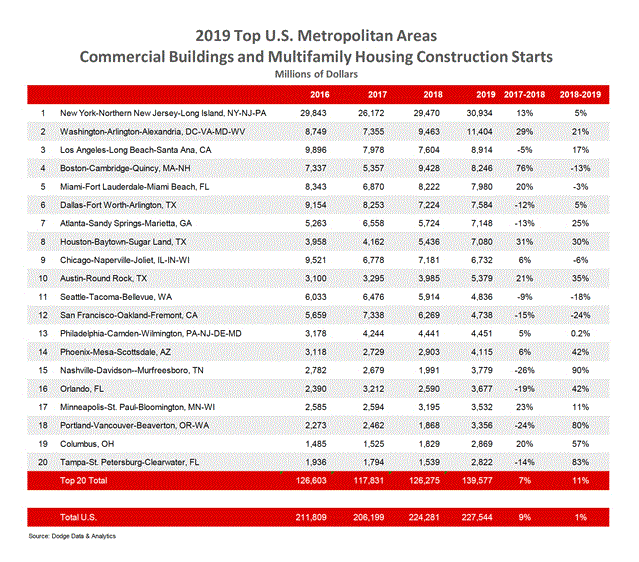Commercial, multifamily construction accelerated in top metro areas in 2019
The value of commercial and multifamily construction starts in the top 20 metropolitan areas of the U.S. gained 11 percent in 2019, reaching $139.6 billion, according to Dodge Data & Analytics.
The New York-Northern New Jersey-Long Island area was the largest market for commercial and multifamily starts at $30.9 billion. However, New York’s rate of growth eased in 2019 to 5 percent from a 13 percent gain in 2018.
The Washington, D.C. area held on to second place in 2019, posting an 18 percent gain to $11.4 billion. The Los Angeles metro jumped from fifth place in 2018 to third in 2019 due to a 17 percent increase that brought the value of commercial and multifamily starts to $8.9 billion.
Multifamily activity was the main driver behind the increase moving 9 percent higher over 2018.
Nationally, commercial and multifamily starts were up 1 percent in 2019 at $227.5 billion. The top 10 metropolitan areas gained 8 percent during the year, with seven of the 10 reporting year-over-year gains. In second-tier metropolitan areas (those ranked 11-20), gains in commercial and multifamily starts were stronger at 17 percent, with eight of these 10 also posting growth.
The second-tier metro areas, which are ranked 11-20, posting gains were experienced in Philadelphia-Camden-Wilmington – up less than 1 percent ($4.5 billion); Phoenix – increasing 42 percent ($4.1 billion), Nashville – up 90 percent ($3.8 billion); Orlando – up 42 percent ($3.7 billion); Minneapolis – gaining 11 percent ($3.5 billion); Portland, Ore. – moving 80 percent higher ($3.4 billion); Columbus – up 57 percent ($2.9 billion); and Tampa – up 83 percent ($2.8 billion). The two markets posting declines in starts were San Francisco, down 24 percent ($4.7 billion) and Seattle down 18 percent ($4.8 billion).

The 10 second-tier metropolitan areas accounted for 17 percent of U.S. commercial building and multifamily starts, up from 15 percent in 2018.
The commercial and multifamily total is comprised of office buildings, stores, hotels, warehouses, commercial garages, and multifamily housing. Not included in this ranking are institutional building projects (e.g., educational facilities, hospitals, convention centers, casinos, transportation terminals), manufacturing buildings, single-family housing, public works, and electric utilities/gas plants.
Nationwide, commercial and multifamily starts made a tepid gain — inching 1 percent higher from $224.3 billion in 2018 to $227.5 billion last year. Multifamily starts, however, fell 5 percent to $95.2 billion while commercial starts rose 7 percent to $132.3 billion. Commercial starts in the top 10 metro areas posted a much stronger gain, increasing 17 percent for the year against a 1 percent decline in multifamily starts. In the second-tier metro areas, multifamily starts were up 1 percent in 2019, while commercial building starts moved 35 percent higher.
“Commercial construction starts continue to be the bulwark of U.S. construction activity as strong demand for office and warehouse buildings pushes the value of construction to higher levels,” stated Richard Branch, chief economist for Dodge Data & Analytics. “Multifamily starts, however, are past their peak and have entered cyclical decline.
“The growing divide however between the larger and smaller metro areas was stark in 2019. While commercial and multifamily starts in the top 20 metro areas in the country moved 11 percent higher in 2019, those metros ranked 21-50 lost 7 percent,” Branch continued. “For 2020, multifamily construction starts are likely to continue lower as the declines broaden to more and more metropolitan areas. Meanwhile, commercial starts have posted gains for nine consecutive years, but a slowing economy in 2020 will likely lead to fewer large value projects, causing national starts to pull back from their 2019 level.”
The largest multifamily building to break ground in 2019 was the $629 million Pacific Park Mixed-Use project in Brooklyn. Also getting underway in 2019 was the $600 million 601 W. 29th Street building and the $500 million second phase north tower of the Hunters Point South.
Commercial starts, however, were essentially flat in 2019 with gains in warehouses and parking structures offsetting declines in office, hotel, and retail buildings. The largest commercial structures to break ground in 2019 were the $1.1 billion TSX Broadway Hotel, a $400 million consolidated rental car facility at Newark International Airport (recorded in the Dodge historical starts database as a parking structure), and a $300 million warehouse on Staten Island.
